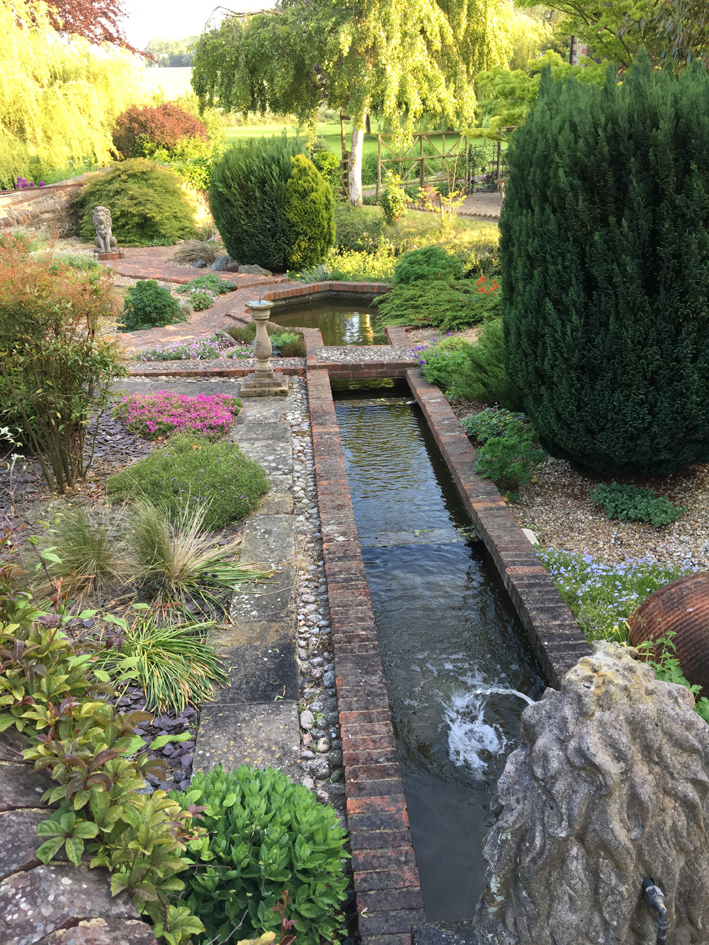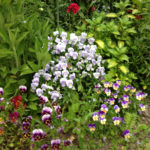From Josh at Polhill Garden Centre

Last year, England experienced the driest summer in almost 100 years.
As we move deeper into June, Josh Novell – gardening expert and director of Polhill Garden Centre, a Kent-based garden centre – has put together the following advice on drought-proofing gardens, so readers can prep in time for forecasted dry spells.
7 Expert Tips on Drought-resistant Gardening
“All gardeners in the UK need to consider how our changing climate will impact the plants in our gardens,” says Josh.
“Last July was the driest in England since 1935. Weeks without rain led to hosepipe bans, and gardens went without water from rain or irrigation well into August when various local environment agencies declared a drought.”
“Xeriscaping is a word we were hearing a lot towards the end of 2022, meaning gardening with dry weather and droughts in mind. This is likely to become even more popular as we move into the summer of 2023.”
“There are certain things UK gardeners can do to make their gardens more drought-resistant and drought-tolerant and protect their plants and lawns during dry months.”
1. Dig in organic matter
Digging specific types of organic matter in soil when planting or sowing seeds makes a big difference to the amount of water that can be retained by the soil, and filtered through the plant’s roots.
The best kinds of organic matter to retain moisture include mushroom compost, composted bark, farmyard manure and well-rotted garden compost.
Dig this into the ground deeply so that water is well-retained at the root level; around 10cm (4 inches) should do it.
2. Pre-soak plants
If you are re-planting, soak plants in their pots in a water source first. You can use a container, bathtub or sink filled with a few inches of water.
Ensure the pot has drainage holes.
Once bubbles stop rising, take them out – this will usually be around 15 to 20 minutes but depends on the plant’s size, breed and thirst levels.
This process allows your plant’s roots to soak up as much water as possible before they go in the ground or are re-potted.
3. Use mulch after watering
Laying certain substances on the ground can help the soil underneath to retain moisture for longer, keeping it cool in the sun and effectively adding a layer of insulation.
Lay about 5-8cm (2-3 inches) of either compost, straw or mulch, covered by gravel after planting. Doing so at this stage helps keep the moisture available for the roots at their crucial growing period and means they will be stronger and more drought tolerant when they are more established plants.
4. Opt for plants with grey leaves
Plants with green-grey or silver leaves need less water, making them great options for naturally drought-tolerant plants.
A good silver-leaved perennial is Senecio candidan – also called ‘angel wings’. This plant features large, silver leaves and actually thrive in low-moderate moisture soil, which makes them perfect for dry weather. These can be planted in hanging baskets or straight in the ground – they look lovely in borders.
Other great silver shrubs and bushes options include Helichrysum petiolare, Goring Silver, Santolina chamaecyparissus, cotton lavender and Convolvulus cneorum, literally translating to ‘silver bush’. All of these plants are low maintenance when it comes to watering and – as long as the soil retains water well – are naturally drought-resistant plants.
Lychnis coronaria, or rose campion, is ideal for those looking for blooms. Though this is quite a short-lived perennial, it features long-lasting magenta flowers, silver-grey stems and thrives in drier soil.
5. Water plants when small
If you aim to plant small specimens of plants, you can water them until they are established and then wean them off water as they become established.
Doing this will help make them gradually more drought tolerant, as they will gradually get used to their growing environment as they develop. ‘Water in’ all new plants (and keep them watered in the first season), and this will ensure they can establish well. Once they are established, they will become much more resistant to dry spells.
This process will also help their roots to become more developed, which means they can grow downwards and access water beneath the surface more effectively.
6. Always remove weeds
Stay on top of weeding if you want to help other plants survive drier months. Like any other plant, weeds have roots that absorb water from the soil. This can mean they take away crucial resources from other plants.
Weed your garden about once a week and be aware of timing, which is very important; younger and less developed will be much easier to pull out than those with established roots.
7. Choose drought-resistant plants
If you’re trying your hand at xeriscaping, it’s worth bearing in mind that there are several varieties of plants that need very little water to survive and thrive.
Low-water garden plants can usually be identified by one or more characteristics that help them to minimise water loss and maximise moisture absorption.
Plants with very broad leaves – particularly those with deep lobes around the edges – may be more naturally drought tolerant, as there is less leaf space in need of water.
Others have waxy leaves, built to keep water in, known as succulents. Succulents need very little water and can thrive in hot, humid conditions, absorbing water vapours from the air and storing this for weeks.
Other drought-resistant plants have furry leaves, which work to trap moisture for longer.
As well as these features, there are several varieties of deep-rooted plants, which have long roots that absorb moisture well below the surface level of the soil.
Generally speaking, the smaller the plant, the less water it needs, so opting for smaller-sized plants in your garden can make a big difference during periods where water is more scarce.
Below are some good examples of drought-tolerant plants for UK gardens:
Perennials
Euphorbia – or Spurges, should be planted straight in the ground ideally, but they can also survive in containers. As long as they are watered in their early life stages, they will survive with minimal watering in well-draining, nutrient-dense soil.
Bergenia – a plant with wide flat leaves and small pink flowers, Begenia is best planted with organic matter, though it is quite hardy and will tolerate poor soil. Once established, Bergenias will cope with dry conditions.
Heuchera – also known as Coral bells, this grey-leaved plant is best planted in dappled shady spots. They retain water well so long as they get enough in their infancy; when first planted, make sure they are well watered in well-draining soil, ideally with a loam-based compost.
Echinops – or Globe thistle, is an interesting plant featuring spiky-looking purple flowers with spherical heads. If you are planting Echinops, it’s best to opt for an area in full sun or partial if this is impossible (it should get at least 5 hours of sunlight daily). Plant in a loam-based compost, ideally digging in organic matter to ensure the soil drains well. This plant will continue to thrive with minimal water so long as it is established by giving plenty of water and keeping the soil moist as a seedling and small plant.
Succulents
Aloe vera – is a well-known succulent that can be grown indoors and outdoors. So long as it has plenty of sunlight, it will thrive with minimal water. When planted outside, Aloe tends to survive longer without water than when kept inside unless conditions are especially arid. In hot and humid conditions, Aloe vera will take water vapours from the air and store them.
Plant straight in the ground or in containers.
Lampranthus – commonly called Dewplants – are happy in dry and poor soil as long as they’re in full sun. They often grow from crevices in rocks or in very dry soil, so can withstand very dry conditions.
Shrubs
Hebe – this small hardy shrub features purple and pink blooms during summer and is a great option for those interested in xeriscaping; as long as the soil is nutrient-dense, it only needs watering every fortnight. This shrub will tolerate both partial shade and full sun.
Lavender – this fragrant floral shrub is well-known for being drought tolerant but requires plenty of water until it is established in size. Plant in the ground, with lots of direct sunlight.
Halimium -sometimes called Rock-roses – is a low-spreading shrub that thrives in dry conditions. Plant in full sun, with well-draining soil, and enjoy its small yellow and white flowers throughout summer.
Hanging Basket Plants
Felicia – or Kingfisher daisy – is a drought-resistant perennial plant that is particularly suited to hanging baskets but can also be planted in containers or straight in the ground. Ensure soil is moderately fertilised and well-draining and water on a fortnightly basis.
Verbena – a perennial flower that gardeners often plant in growing pots, window boxes and hanging boxes. These will survive with less water than many hanging basket flower varieties, needing weekly watering.
Diascia – if planted in hanging baskets, these pretty little flowers need well-drained loam or chalk-based compost and moderate water until they are established when they can survive quite well with weekly watering.


